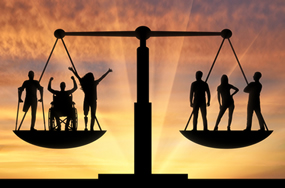|
|

|
| |
Onondaga County/Syracuse Commission on Human Rights
John H. Mulroy Civic Center
15th Floor East
421 Montgomery Street
Syracuse, NY 13202
(315) 435-3565
Our office is staffed from
8 am to 4 pm. Mon - Fri.
|
|
|
|
|
Things to Remember When Interacting With People With Disabilities
The information below provides a series of helpful tips for interacting with people with disabilities in a sympathetic and appropriate way. These tips were drawn from a disability etiquette presentation developed for the Onondaga County Board of Elections by leaders from several CNY disability service and advocacy organizations, including AURORA, ARISE, ENABLE and Disabled in Action. |
- Always try to use "Person First Language." A person with a disability is a person FIRST. i.e. a PERSON who uses a wheelchair, a PERSON who is blind. A slogan commonly used during disability community demonstrations is "See Me, Not My Disability"
- Always speak directly to a person with a disability, even if they are accompanied by a family member, friend, aide or assistant.
- Try to establish eye contact. For instance, if you are interacting with a person who uses a wheelchair, consider sitting down to be at eye level with them.
- Realize that people with the same disability will have different needs & abilities & strategies to deal with any challenges they face. A person with a disability may also have good days & bad days. They may also may have different needs or levels of ability over time - from one year to the next, from week to week, or from day to day.
- It is OK to ask a person with a disability “Do you need assistance?” BUT don’t be offended if answer is an emphatic “No” IF the person says “yes”, THEN ask them HOW you can assist them. Never assume that you know what kind of assistance a person with a disability needs or wants. Assume that they know their own needs better than you do!
- Avoid antiquated negative references to people with disabilities. Don't use words like crippled" or "retarded." Even "handicapped" parking spaces can instead be referred to as "accessible parking."
- Don't use labels that suggest that all people with the same disabilities have the same experiences. Avoid phrases like "the blind" or "the disabled." Also, don't assume that people with the same disability would automatically know each other.
- Avoid referring to people with disabilities with words that suggest loss or suffering. Don't talk about somoeone being a "victim" of a disabling condition, or being "wheelchair bound" or "confined to a wheelchair." For people who use wheelchairs, their wheels represent and enable their freedom and their independence.
- Never draw public attention to a person with a disability. Treat them in the way you would interact with any other person you happen to encounter.
- Don't reach out and touch a person with a disability without their permission. Similarly, don't lean on or otherwise touch the wheelchair of a person while they are using it. However, it is appropriate to touch the arm or shoulder of a person who is Deaf in order to get their attention.
- After your 1st interaction with a person with a disability, it is OK to ask them if there is anything that would make your next encounter easier for them or more accessible.
|

|
Consider This.... |
The odds are that YOU may experience life with a disability at some point:
- 1 of every 3 people in U.S. will develop a temporary OR permanent disability during their lifetime.
- 1 of every 3 people will develop a hearing loss during their lifetime & hearing loss can begin as early as 45.
- 1 out of every 6 people will develop a visual impairment by the time that they reach 65.
Approximately 57.6 million people in the U.S. report having a disability. In 2010 this was equivalent to 19% of people living in the community. More than half of these respondents were adults between the ages of 18 and 65. These statistics essentially make people with disabilities the largest minority group in the United States.
The Americans with Disabilities Act (ADA) Prohibits Discrimination Against....
- people with Disabilities
- people with a history of disability (ex. a survivor of cancer)
- people perceived as having a disability (ex. someone with visible scars)
The ADA prohibits such discrimination in employment, housing and in public accommodations (public and private facilities or services that available to the public). |
|
| |
|
|

